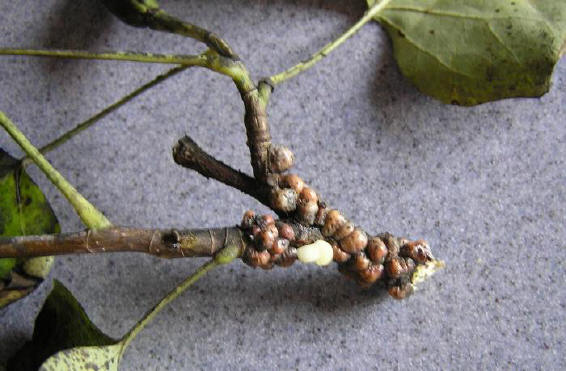|
Combating Sooty Mold and Scale in Tulip Trees
Bill Devlin
Adams County Master Gardener
 A neighbor came to me recently with some diseased leaves from her tulip tree. She was
quite concerned because a black mold had developed that was covering the top side of the leaves and discoloring the grass below. I took photos of the samples displaying the
diseased conditions and forwarded them to the Ag Center for Master Gardener diagnosis. A neighbor came to me recently with some diseased leaves from her tulip tree. She was
quite concerned because a black mold had developed that was covering the top side of the leaves and discoloring the grass below. I took photos of the samples displaying the
diseased conditions and forwarded them to the Ag Center for Master Gardener diagnosis.
The diagnosis came back quickly. According to Mary Ann Ryan, Master Gardener Coordinator for Adams County, the bumpy stuff is tulip tree
scale. The black stuff is sooty mold. The scale leaves a sticky residue, and the mold then grows on top of it. This scale will kill the tree. The sooty mold cuts back on
photosynthesis, so long term, it can be deadly as well. The best thing to do is spray with a horticultural oil spray. Be sure to read the label as far as temperature to apply
and how much to mix (there will be a dormant and an active growing formulation.)
A search on the internet yielded additional information at the following related site:
http://www.ppdl.purdue.edu/PPDL/expert/Tulip_Tree_Scale.html Our sister extension service at Purdue University yielded the following question and answer which are right
on with my neighbor’s concern:

Question: I have black scale-like insects covering the twigs of a five year old Tulip tree. During August, there are also scale-like
white/grey fuzzy insects that actively crawl around that I assume is the mobile stage of these scales. Also the tree is surrounded by wasps, bees, and other insects. What
should I do?
Answer: It looks like your problem is with an insect called a tulip tree scale. These insects are immobile as adults and are usually dark in
color. After they hatch from their eggs, the crawlers are mobile. These insects break down cells for sap and other nutrients in the tree and excrete a clear substance called
honeydew. This sugar-like substance is a favorite meal for ants, bees, wasps, and a fungus called sooty mold.
Repeated heavy infestations can result in death of branches. The use of pesticides can be detrimental to beneficial insects, such as lady
beetles and microscopic wasps which are natural enemies of the scales. However, if infestation is severe, it is possible to kill the crawlers during mid-August when they are
active using a systematic insecticide. Then use a dormant oil spray next spring. When using pesticides, carefully read and follow label directions. --Nathan E. Saxe (June 9,
1998)
The tulip tree is a beautiful tree sometimes referred to as "yellow poplar." It is also called canoe wood, saddle leaf tree and white wood.
Liriodendron are easily recognized by their leaves, which are distinct, having four lobes in most cases and a cross-cut notched or straight apex. Leaf size varies from 8-22
cm long and 6-25 cm wide. That is about 6" by 7" for us old timers.
Flowers are 3-10 cm in diameter and have nine tepals, three short outer sepals and six inner petals, yellow-green with an orange flare at the
base. They are superficially similar to a tulip in shape, hence the tree's name.
Liriodendron are also easily recognized by their general shape, with the higher branches sweeping together in one direction. They are also
recognizable by their height, as the taller ones usually protrude above the canopy of oaks, maples, and other trees -- more markedly with the American species. Appalachian
cove forests often contain several tulip trees of height and girth not seen in other species of eastern hardwood.
If you have a tulip tree displaying signs of scale or sooty mold, stock up on dormant oil spray and be prepared to saturate the tree in early
spring if you want to keep it. Given their stately nature and lovely flowers, my bet is that you do.
Read other articles about tree care
Read other articles By Bill Devlin |